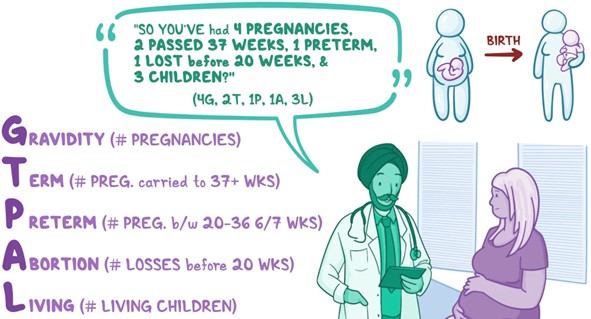A client at 39 weeks gestation is admitted in early labor. During the focused assessment, the practical nurse (PN) reviews the obstetrical history of the client who states that she has been pregnant five times but has only two living children, both of whom were full-term. The other three pregnancies were miscarriages during the first trimester. Which parity should the PN document for the term, premature, abortion, and living children (TPAL) for this client?
Term 2, Premature 0, Abortion 3, Living 2.
Term 6, Premature 3, Abortion 3, Living 2.
Term 2, Premature 1, Abortion 0, Living 3.
Term 3, Premature 0, Abortion 3, Living 2.
The Correct Answer is A
TPAL stands for Term, Premature, Abortion, and Living children, and it is used to document a client's obstetrical history.
In this case, the client has had a total of 5 pregnancies:
- Two pregnancies resulted in full-term (term) births, so the Term value is 2.
- Three pregnancies resulted in miscarriages during the first trimester (abortion), so the Abortion value is 3.
- The client has two living children, so the Living value is 2.
- There is no mention of any premature births, so the Premature value is 0.
Therefore, the appropriate documentation for this client's TPAL is Term 2, Premature 0, Abortion 3, and Living 2.

Nursing Test Bank
Naxlex Comprehensive Predictor Exams
Related Questions
Correct Answer is D
Explanation
While the use of cocaine and heroin can pose various health risks, including cardiovascular complications, respiratory problems, and infectious diseases, Hepatitis is particularly associated with injection drug use, such as heroin. Hepatitis is an inflammation of the liver that can be caused by viral infections, including Hepatitis B and C. Sharing contaminated needles or other drug paraphernalia increases the risk of contracting Hepatitis. These viral infections can lead to chronic liver disease, liver cirrhosis, and even liver cancer if left untreated. Therefore, among the options provided, Hepatitis is the greatest health risk for this client due to the mode of drug administration and associated risks of viral transmission.
A, B, and C- It's important to note that while diabetes, glaucoma, and hypertension are all significant health conditions, they are not directly associated with the use of cocaine and heroin as drugs of choice. However, individuals who engage in substance abuse may still be at risk for developing or exacerbating other health conditions due to the overall impact on their physical and mental well-being.

Correct Answer is A
Explanation
The finding that is the highest priority for the PN to report to the charge nurse is the blood urea nitrogen (BUN) level of 75 mg/dL or 12.9 mmol/L. This result indicates an elevated BUN level, which can be indicative of impaired kidney function. In a client receiving chemotherapy, an elevated BUN level may suggest chemotherapy-induced nephrotoxicity or other kidney-related complications. Prompt reporting is crucial to ensure appropriate intervention and management of the client's kidney function.
B. While the platelet count of 135,000/mm3 or 135 x 109/L is slightly below the normal reference range, it does not pose an immediate life-threatening risk. However, it should still be monitored and reported to the healthcare team for ongoing assessment and evaluation.
C. Decreased deep tendon reflexes may be an expected side effect of certain chemotherapy medications or a manifestation of neurotoxicity. While this finding should be documented and monitored, it is not as urgent as the elevated BUN level.
D. Periodic nausea and vomiting are common side effects of chemotherapy, but they may also be indicative of other underlying issues such as dehydration, electrolyte imbalances, or gastrointestinal complications. While this finding should be addressed and managed, it is not the highest priority compared to the elevated BUN level.
Whether you are a student looking to ace your exams or a practicing nurse seeking to enhance your expertise , our nursing education contents will empower you with the confidence and competence to make a difference in the lives of patients and become a respected leader in the healthcare field.
Visit Naxlex, invest in your future and unlock endless possibilities with our unparalleled nursing education contents today
Report Wrong Answer on the Current Question
Do you disagree with the answer? If yes, what is your expected answer? Explain.
Kindly be descriptive with the issue you are facing.
